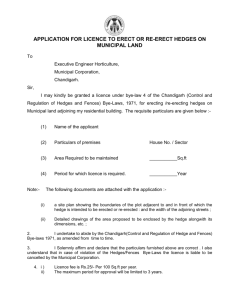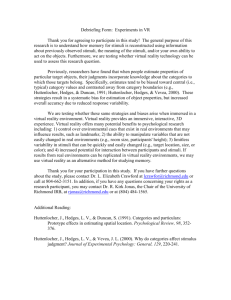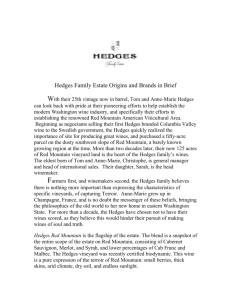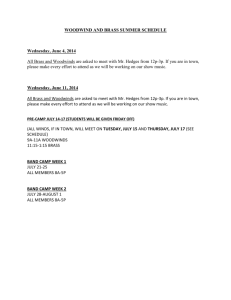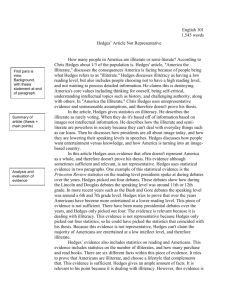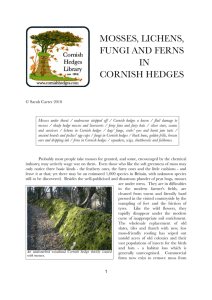Explore Cornish Hedges
advertisement
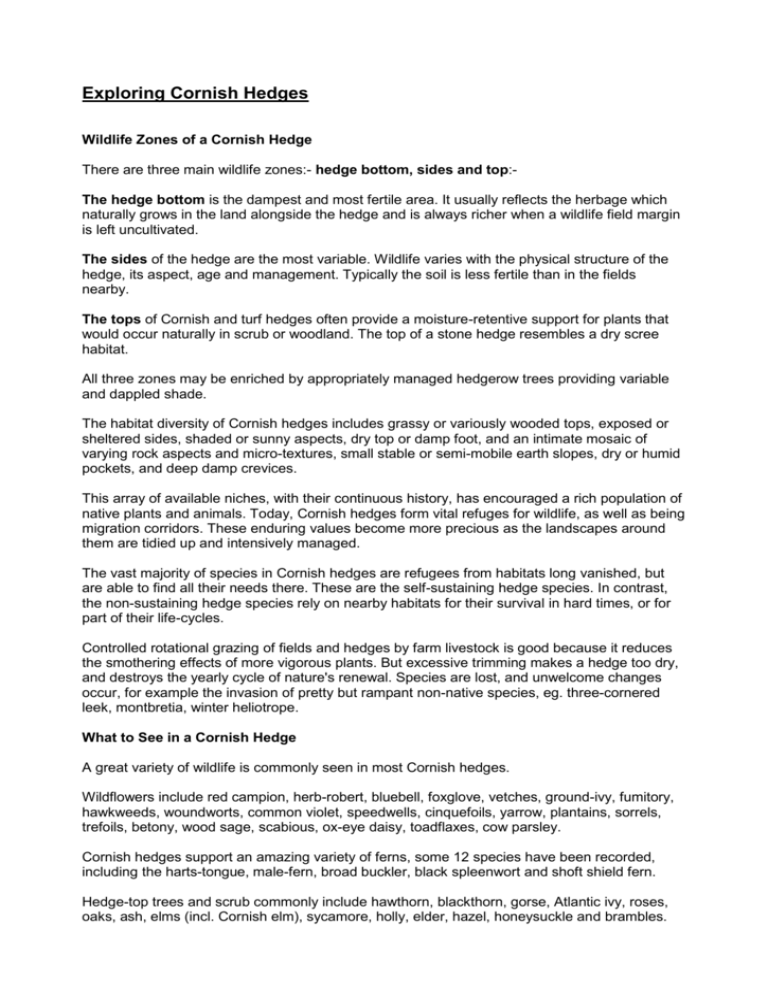
Exploring Cornish Hedges Wildlife Zones of a Cornish Hedge There are three main wildlife zones:- hedge bottom, sides and top:The hedge bottom is the dampest and most fertile area. It usually reflects the herbage which naturally grows in the land alongside the hedge and is always richer when a wildlife field margin is left uncultivated. The sides of the hedge are the most variable. Wildlife varies with the physical structure of the hedge, its aspect, age and management. Typically the soil is less fertile than in the fields nearby. The tops of Cornish and turf hedges often provide a moisture-retentive support for plants that would occur naturally in scrub or woodland. The top of a stone hedge resembles a dry scree habitat. All three zones may be enriched by appropriately managed hedgerow trees providing variable and dappled shade. The habitat diversity of Cornish hedges includes grassy or variously wooded tops, exposed or sheltered sides, shaded or sunny aspects, dry top or damp foot, and an intimate mosaic of varying rock aspects and micro-textures, small stable or semi-mobile earth slopes, dry or humid pockets, and deep damp crevices. This array of available niches, with their continuous history, has encouraged a rich population of native plants and animals. Today, Cornish hedges form vital refuges for wildlife, as well as being migration corridors. These enduring values become more precious as the landscapes around them are tidied up and intensively managed. The vast majority of species in Cornish hedges are refugees from habitats long vanished, but are able to find all their needs there. These are the self-sustaining hedge species. In contrast, the non-sustaining hedge species rely on nearby habitats for their survival in hard times, or for part of their life-cycles. Controlled rotational grazing of fields and hedges by farm livestock is good because it reduces the smothering effects of more vigorous plants. But excessive trimming makes a hedge too dry, and destroys the yearly cycle of nature's renewal. Species are lost, and unwelcome changes occur, for example the invasion of pretty but rampant non-native species, eg. three-cornered leek, montbretia, winter heliotrope. What to See in a Cornish Hedge A great variety of wildlife is commonly seen in most Cornish hedges. Wildflowers include red campion, herb-robert, bluebell, foxglove, vetches, ground-ivy, fumitory, hawkweeds, woundworts, common violet, speedwells, cinquefoils, yarrow, plantains, sorrels, trefoils, betony, wood sage, scabious, ox-eye daisy, toadflaxes, cow parsley. Cornish hedges support an amazing variety of ferns, some 12 species have been recorded, including the harts-tongue, male-fern, broad buckler, black spleenwort and shoft shield fern. Hedge-top trees and scrub commonly include hawthorn, blackthorn, gorse, Atlantic ivy, roses, oaks, ash, elms (incl. Cornish elm), sycamore, holly, elder, hazel, honeysuckle and brambles. Birds most frequently seen are crows, finches, wren, robin, blackbird, hedge sparrow, also buzzard which haunts the hedges to prey on rabbits and large insects. Mammals most frequently seen are rabbit, fox, stoat, wood mouse, voles and shrews. South-facing hedges provide excellent basking opportunities and shelter for reptiles:- adder, grass snake, slow worm, and common lizard. Damp hedge bottoms harbour toads and frogs. Wildflowers especially seen in stone hedges are wall pennywort, stonecrop and wild thyme, with spleenworts and polypody ferns, drystone mosses, yellow crustose and grey-green foliose lichens, dog's tooth lichen, and cladonia species. Turf hedges are particularly good for hedgerow shrubs such as guelder rose, spindle, bullace; and for wildflowers such as wild arum, hemp agrimony, deadnettle, and meadow vetchling. Hedge-nesting birds such as thrush, blackbird, greenfinch, chaffinch and whitethroat, and the less common small mammals such as weasel and dormouse may be found in turf hedges. When to See Biodiversity in Cornish Hedges Spring The early golden "stars and suns" of lesser celandine and dandelion are followed by blackthorn blossom, stitchworts, primroses, violets and early purple orchids. Birds are gathering nesting materials. Bumblebees and other insects are waking from hibernation. Lizards warm themselves on sunny stones. Croziers of abundant fern fronds are emerging. Summer The high season for wildflowers and insects. Butterflies often seen along hedges are speckled wood, holly blue, green-veined white, hedge brown, wall brown, small tortoiseshell, red admiral and painted lady. Less common are the orange tip, comma, silver-washed fritillary. Pretty daytime moths include magpie moth, common carpet and burnet moths. Also attractive caterpillars such as mullein moth and elephant hawk feed on hedgerow plants. Birds are nesting and swallows may be seen swooping over hedges for insects. Autumn Late flowers of purple and gold, betony, golden rod and hawkweeds; and all the berries, hawthorn, holly, blackberry, elder, bryony. This is the time to see spiders when on a misty morning the hedges are sparkling with various gossamer, funnel and orb webs. Moth caterpillars eg "woolly bears" such as drinker, roam over the hedge to find a place to pupate. Look out for toadstools, puffballs and other fungi. Winter The time to see the hedge structure when the growth has died down. Foraging birds are visible, including redwing and other winter migrants. The masses of mosses become fresh and green, and show up well. Many wildflowers such as red campion produce blooms throughout winter. On mild evenings, bats come out to feed. Early Morning This is the time to see hedgerow mammals quietly going home to their burrows in the hedges, and the birds waking up. A Sunny Day This is the time to see wildflowers and the myriad insects, beetles, shield bugs, hoverflies etc that are associated with them, and to hear grasshoppers and crickets. A Wet Day This is the time to see snails, especially the pretty yellow, brown or pink brown-lipped snail which is often seen on hogweed. Many interesting tiny snails such as two-toothed snail, round snail, chrysalis snail and hairy snail also live in Cornish hedges. Evening This is the time to see birds going to roost. In summer, bats come out to hunt along the hedges, usually the pipistrelle. As it gets dark the many species of moths wake from their daytime sleep in the hedge, and feed on the hedgerow flowers. Badgers and foxes forage along the hedges. Tawny and barn owls hunt over the hedges for mice and voles. Hedgehogs emerge from hiding. All the year round Our Cornish hedges show a panorama of nature's seasons. The structure of stone, earth, bark and greenery forms a unique motherland for the annual cycle of a multitude of species. It provides the food chain through flower to seed, and for hunter and prey. Our hedges have their own system to support life, which continues indefinitely as long as man's necessary work keeps disturbance to the minimum; for example trimming alternate sides of the hedge rotationally, and only during the winter. Looking at Wildlife in Cornish Hedges Most hedges are on private land and the owner's consent should be obtained before visiting, except where using a public footpath or bridleway. Fortunately Cornwall is blessed with very many public footpaths in every part of the county. These usually run alongside field hedges in the countryside, giving ample access to them and opportunities for their close study. Many of the footpaths are sign-posted from the roadside, but a map is useful for following footpaths across fields. Roadside hedges are more accessible but traffic can be a real hazard, especially in our narrow lanes. Some land, particularly moorland, has open access, under legislation or by agreement. Enquires should be made locally.
